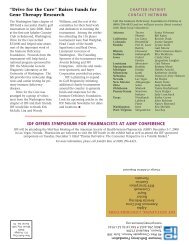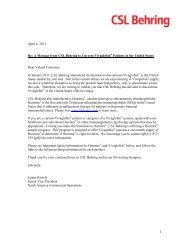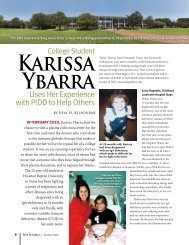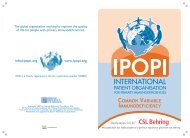IDF Patient & Family Handbook for Primary Immunodeficiency ... - IDFA
IDF Patient & Family Handbook for Primary Immunodeficiency ... - IDFA
IDF Patient & Family Handbook for Primary Immunodeficiency ... - IDFA
Create successful ePaper yourself
Turn your PDF publications into a flip-book with our unique Google optimized e-Paper software.
48<br />
DiGeorge Syndrome<br />
Diagnosis of DiGeorge Syndrome<br />
The diagnosis of the DiGeorge Syndrome is<br />
usually made on the basis of signs and symptoms<br />
that are present at birth or develop soon<br />
after birth. Some children may have the facial<br />
features that are characteristic of the DiGeorge<br />
Syndrome. Affected children may also show signs<br />
of low blood calcium levels as a result of their<br />
hypoparathyroidism. This may show up as low<br />
blood calcium on a routine blood test, or the infant<br />
may be “jittery” or have seizures (convulsions) as<br />
a result of the low calcium. Affected children may<br />
also show signs and symptoms of a heart defect.<br />
They may have a heart murmur that shows up<br />
on a routine physical exam, they may show signs<br />
of heart failure, or they may have low oxygen<br />
content of their arterial blood and appear “blue” or<br />
cyanotic. Finally, affected children may show signs<br />
of infection because of the underdevelopment of<br />
their thymus gland and low T-lymphocyte levels.<br />
Some children have signs or symptoms at birth or<br />
while they are still in the hospital nursery. Others<br />
may not show signs or symptoms until they are<br />
a few weeks or months older. Some children and<br />
adults are diagnosed at a much older age due<br />
to speech delay, qualitative speech problems, or<br />
feeding problems.<br />
There is a great deal of variation in the DiGeorge<br />
Syndrome from child to child. In some children,<br />
all of the different organs and tissues are<br />
affected. These children have the characteristic<br />
facial characteristics, low blood calcium from<br />
hypoparathyroidism, heart defects and a<br />
deficiency in their T-lymphocyte number and<br />
function. In other children, all of the different<br />
organs and tissues may not be affected, and<br />
the organs and tissues that are affected may be<br />
affected to different degrees.<br />
Not only do children with the DiGeorge Syndrome<br />
differ in the organs and tissues that are affected,<br />
but they also differ in terms of how severely a<br />
given organ or tissue is affected.<br />
In the past, the diagnosis of the DiGeorge<br />
Syndrome was usually made when at least three<br />
of the characteristic findings described above were<br />
present. Un<strong>for</strong>tunately, this caused many mild<br />
cases to be missed. In recent years, the genetic<br />
test has been more widely used. Over 90% of<br />
patients with the clinical diagnosis of DiGeorge<br />
Syndrome have a small deletion of a specific<br />
portion of chromosome number 22 at position<br />
22q11.2. This can be identified in a number<br />
of ways, but the most common way is a FISH<br />
analysis (<strong>for</strong> Fluorescent In Situ Hybridization). Use<br />
of a FISH analysis test has made the diagnosis<br />
of DiGeorge Syndrome more precise and more<br />
common. Approximately 1 in 4000 babies have<br />
DiGeorge Syndrome or chromosome 22q11.2<br />
deletion syndrome. For patients who do not have<br />
the deletion, the diagnosis continues to rely on the<br />
characteristic combination of clinical features.
















